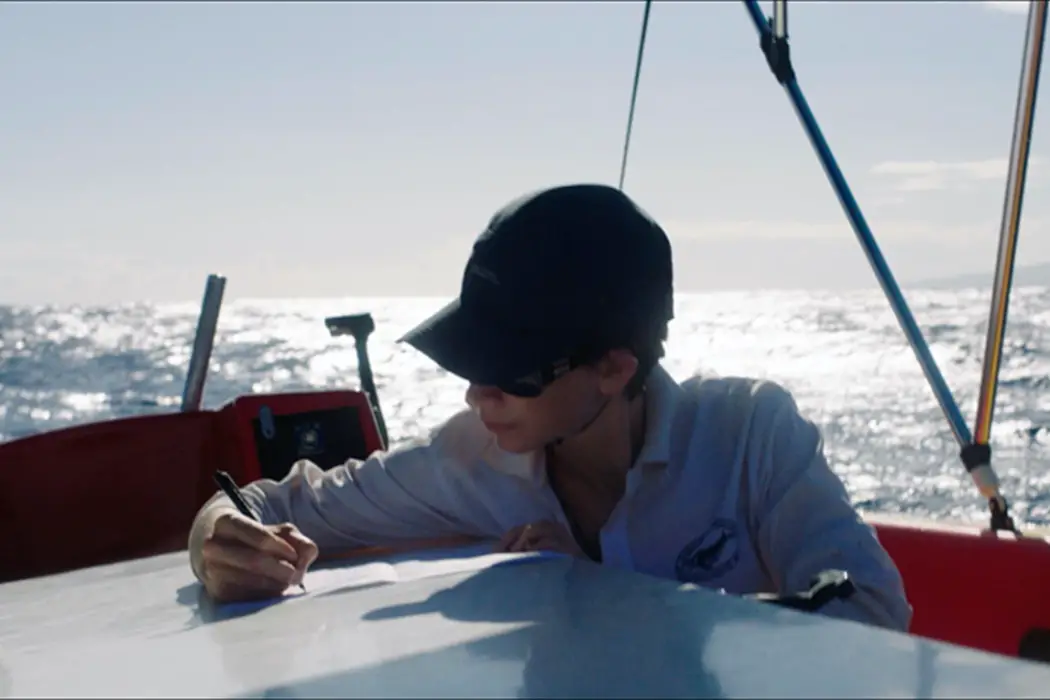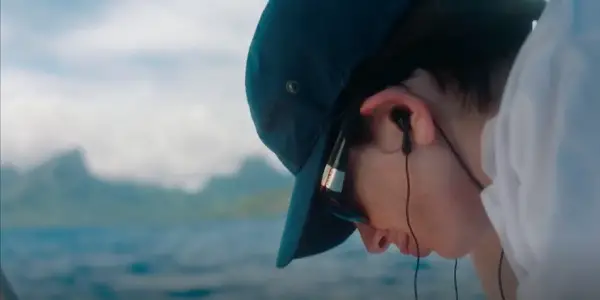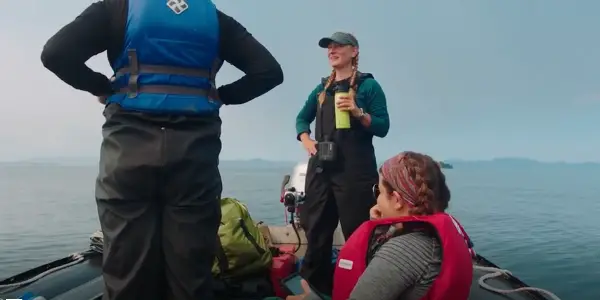FATHOM: Whale Researcher Documentary Dives Deep

Film critic, Ithaca College and University of St Andrews graduate,…
Humpback whales, it turns out, are a lot like birds. Really big birds. At least, in terms of their vocalizations, which are the focus of Dr. Ellen Garland and Dr. Michelle Fournet’s research in Drew Xanthopoulos’ Fathom, a hypnotic, moving documentary about the undersea giants and the people who study them.
The little-seen doc straddles unusual terrain — as neither a profile of the researchers nor a nature doc about the whales, Fathom is a bit of both, combining the excitement of field research with vérité insight into the researchers’ work. Not even their research is exactly the same — Fournet, in Alaska, studies whale greetings, while Garland, in French Polynesia, tracks whale song. But the whales and their songs unify them, and it’s the graceful, Marianas-deep hums, thrums and bouldering thunder timbre of their dense, ancient calls that makes the film cohere.
The documentary, which is streaming on Apple TV+, screened recently at the On the Rocks arts festival in St Andrews, Scotland, where Garland works as a senior research fellow at the university. Fournet is a postdoctoral fellow at Cornell University’s Lab of Ornithology in Ithaca, New York. And as I did my undergrad at Ithaca College and currently study in St Andrews, I think I have a proximal commitment to review Fathom, and I’m worried that someone might egg my flat if I don’t.
Speak Whale To Me
Before they leave for the field, we see their home lives — Fournet’s home is nestled within the verdant upstate New York woods, she’s a very tidy cook, and she has a garden out back and a dog by her side; Garland and her husband seem to be very frantic cooks and have two cats wandering around the house. These scenes are not only endearing, but they remind us of where our characters are coming from while setting up their dynamic. Dog Person versus Cat Person, going into the field to study whales! The rest of Fathom fully immerses itself in their work.
Fathom wants you to know the science. This is not a David Attenborough documentary; only once, at the very end, do we go beneath the waves and look at humpbacks underwater. The majority of Fathom is spent above sea level, with the researchers. The film feels like standing in a natural history museum, looking up at a colossal blue whale skeleton suspended from the ceiling — incidentally, Xanthopoulos includes second-unit shots of a whale skeleton in a museum — or like being in an echo chamber, whale vocalizations reverberating all around you.

“Birds have song. And other whales have song,” Garland says. “But humpback song is even more elaborate. They have rhythm, timed breathing, rhyming and repetition. Hours of patterns within patterns with no clear beginning or end.”
Some vocalizations are the same from region to region, and some songs pop up in populations hundreds of miles apart. Garland’s quest is to track a song across the South Pacific — from Australia to New Caledonia to French Polynesia.
If you’re studying humpback vocalizations, some constituent calls you might listen for are rumbles, swops, droplets, teepees, growls and whups, and Fournet can probably do a realistic impression of any one of them. She goes to Alaska looking for whups specifically, as those, she thinks, are the closest whales have to “hello.” She and her fellow researchers basically drop a speaker into the water, play the sound and use microphones to pick up any responding whale calls to see if there’s a correlation.
Cetacean Station
Fathom finds gorgeous open ocean in the South Pacific and lush, hazy, imposing mountains in Alaska. Xanthopoulos filmed Fathom over several years and acted as his own cinematographer. Stark, lonely shots of Fournet’s boat in the middle of the still Hobart Bay give a sense of the isolation of fieldwork, but Fournet doesn’t seem to mind.
The film’s best moments explore Garland’s homesickness, Fournet’s daunting enthusiasm, and their joint determination to excel in a field that, like most sciences, is male-dominated. “I am just exhausted from everything. To talk about that it’s hard, that it’s challenging, can sometimes be a sign of weakness,” Garland says. “Being female in this field, you don’t want to show any weakness.”
Xanthopoulos and his editor, Robin Schwartz, also find moments of joy. Sometimes, it’s when a whale unexpectedly flips its tail above the surface and the researchers watch from less than a mile away. But mostly, the pleasures of Fathom are the same as films like Jiro Dreams of Sushi or Free Solo: marveling at professionals doing their jobs and then studying them in their downtime. Whether it’s Fournet making plans to have a family and bring them out for fieldwork or Garland giddily listening to whale songs from her rocking boat, the keen editing and empathetic camera give Fathom its beating heart. It’s like what Godard might have said if he were a huge cetology nerd: All you need for a movie is two scientists and a bunch of whales.

But the key component of Fathom is those whale calls. Xanthopoulos and animators Albert Albaladejo and Duncan Elms bring the vocalizations to life with ashy circles on a white background, like the symbols in Arrival. (The illustrations are taken directly from Garland’s models.)
Sound designer Nick Ryan skillfully layers these whale sounds throughout the film, while composer Hanan Townshend blends organs and synths with whale song to create bioacoustic symphonies. He’s Fathom’s secret sauce. Few composers ever make duets with humpback whales, but for Fathom, Townshend gets the chance to do exactly that.
A third of Fathom’s score is whale songs, though the whales go uncredited; a third is Townshend’s orchestrations played by the Budapest Scoring Orchestra with conductor Péter Illényi, orchestrator Samuel Lipman, and oboist Ian Davidson; and a third is both of these sounds combining into an immersive cetacean soundscape. Davidson’s trilling, cycling oboe underscores the softer moments, like Fournet sitting in the sun with her dog, testing equipment. The orchestrations sneak up on you, usually first with Townshend’s gentle piano, then adding strings and whale songs, each component joining the sound body like fish gathering to form a shoal. It feels composed underwater.
Conclusion: Fathom
Apple TV+ unceremoniously dumped the film on its platform with nearly no promotion or theatrical play, which is a shame, because Fathom demands to be heard on the best sound system you can find and seen on the biggest screen possible. As a portrait of the scientific process, Fathom is a fascinating watch.
I could spend hours on the boat with Fournet or Garland, except that it seems very stressful to keep up with whale song recordings. Like The Creeping Garden or Jane, other great low-key, intellectual science docs, Fathom is a science fair of ingenuity, passion, and good humor as well as a deep look at the largest creatures on Earth and how they communicate, a phenomenon we are only now just beginning to decipher.
What do you think of Fathom? Are you a huge whale nerd? Comment below and let us know.
Fathom is available to stream on Apple TV+.
Watch Fathom
Does content like this matter to you?
Become a Member and support film journalism. Unlock access to all of Film Inquiry`s great articles. Join a community of like-minded readers who are passionate about cinema - get access to our private members Network, give back to independent filmmakers, and more.
Film critic, Ithaca College and University of St Andrews graduate, head of the "Paddington 2" fan club.













